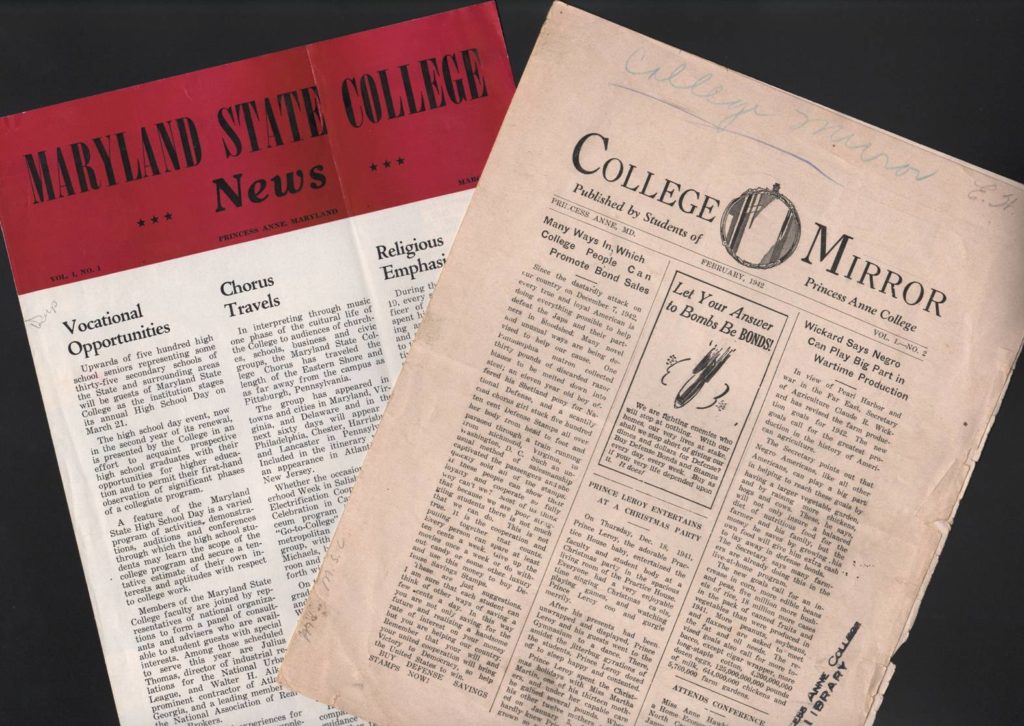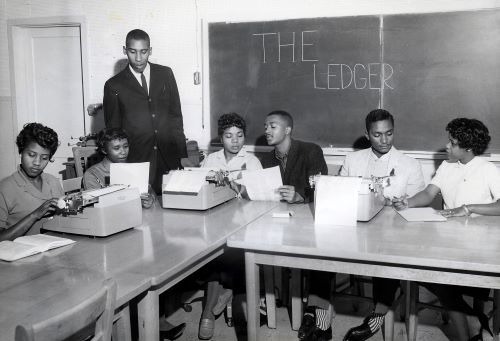
As the University of Maryland Eastern Shore celebrates the 125th anniversary of its founding, students are exchanging news using hand-held electronic devices to transmit “texts,” “tweets” and messages to Facebook, a wildly popular phenomenon in 2011 known as a “social network.”
There was a time when the written word was committed only to paper — and at a far slower pace.
UMES has a colorful history as a locale that nurtured niche publications. At the turn of the 20th century, in fact, the institution had a “Printery Department,” where students learned to use printing presses that produced much-needed revenue. Morgan College bulletins and catalogs that included information about its branch campus in Princess Anne were printed on the far-away campus in Somerset County.
One of the earliest known publications at Princess Anne Academy, as UMES was once known, was “The P.A.A. News.” The Miles’ family from Crisfield, Md., which counts three generations of graduates from the institution, donated a 1935 copy that appears to be composed using a typewriter. The staff box promised it would be produced monthly during the school year.
A single copy was a nickel when a bison was on one side of the coin and a Native American’s profile on the other. A subscription for all eight copies during the 1935-36 school year was 40 cents. After all, it was the middle of the Great Depression — there were no discounts.
Marizita and Portia C. Miles were listed as editors of the December edition that contained a story on a visiting lecturer, news briefs about alumni who graduated in 1934, and a gossip column called “Things I Never Knew Until Today.”
“… Miss L.L. Brown was asked to sing ‘The Spacious Firmament on High’ and she has promised to do so,” one mild item reads. It refers to Lida L. Brown, a long-serving, beloved administrator during the early 20th century.
In May 1937, Portia Miles’ name appears as news editor of a bi-weekly publication called “The College Mirror,” which had a motto: “To Success Through Adversity.” Her older sister was the “secretary-typist” and by the early 1940s, Marizita was working as a campus librarian.
As America entered World War II, students began producing a more sophisticated version of “The College Mirror.” A February 1942 edition described the “dastardly attack” on Pearl Harbor and encouraged readers to buy war bonds. Another story reported the U.S. Secretary of Agriculture as saying “Negro Americans can play a big part (in the war effort) by having a larger vegetable garden, and by raising more chickens, hogs and cows.”
That same publication also contained a report on the college’s basketball team, which went by the nickname the “Fighting Trojans” and wore blue and orange uniforms — presumably handed down from Morgan College when the two were sister institutions overseen by the Methodist Episcopal Church.
By the time the college was known as “Maryland State” following the war, students were producing a broadsheet called the “Maroon and Gray,” the school colors still in use today. The first edition appeared in March 1951, just as seniors who were members of the first class were about to complete four years of study under the renamed institution.
Lorelle Williams, the step-daughter of college President John T. Williams, was the Maroon and Gray’s editor and penned a front-page article outlining her vision for producing a student newspaper with serious, informative articles. But she also was the subject of a people feature on an inside page.
Williams “has the loveliest hair and complexion on campus,” the unknown author writes. “She isn’t anybody’s idea of a hard-boiled editor with that persuasive little voice and gentle manner.”
It is unclear how long the Maroon and Gray was published, but by 1953 another campus publication surfaced – The Maryland State College News. It was geared toward a faculty and staff audience and was a campus fixture into at least the late 1960s.

Throughout the 1960s, students published a bulletin called “The Ledger.” The 1960 Hawk yearbook includes a staff photo with a caption that says “Continuing to grow in student and faculty favor is ‘The Ledger,’ our only student contribution to the Fourth Estate. ‘Ledger’ has become regular reading material for the entire campus family, and each issue is awaited eagerly by a host of readers.”
The UMES’ Frederick Douglass Library also has copies in its archives of another 1960s student-oriented publication called “The Sentinel,” but the yearbook staff did not see fit to acknowledge its existence in any of the annuals of that era.
In May 1974, the “Hawk Messenger” debuted and was published sporadically into the 21st century.
The college began producing a hard-cover yearbook in 1959 and in 2010; with financial backing from the UMES Office of Alumni Affairs, the staff of the Frederick Douglass Library arranged the conversion of those annuals into digital images that can be viewed over the Internet.
As the university entered the 21st century, it went back into the publishing business and now has a twice-monthly (during the academic year) newsletter, The Key, which focuses on campus news. It is produced in a paper and an electronic format.
Campus news also is published on the university’s web site: www.umes.edu.

